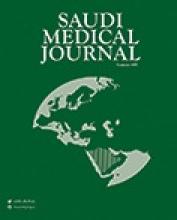In a recent systematic review, student participation in research has been linked to a better short- and long-term medical school educational outcomes. In addition, student research (SR) can help students to make more informed career choices and improve their knowledge and interest towards research in the future.1 Involving students in research has, therefore, become an established practice in many universities worldwide; some medical schools even make it a compulsory part of the curriculum.
Although the concept of SR has been recently introduced into Arab countries, many universities took several steps, over the past few years, to promote the culture of SR and to provide relevant opportunities by establishing many SR initiatives; some official and some student-led. These initiatives provide many research activities, such as research methodology courses, mentorship programs, research opportunities, and national student conferences at which students can present their work, share their experiences, and collaborate for studies. For example, Alfaisal University in Saudi Arabia has established in 2011 the first student-centered undergraduate research committee in the Kingdom.2 In Egypt, there are official student research units in 3 universities and many student research organizations in each university.
Although there are no studies that assess the number of student-authored publications from Arab countries, some cross sectional studies from Jordan, Bahrain, Saudi Arabia, and Kuwait showed rise in students’ interest in medical research.3,4 However, it is not obvious if this rise is leading to subsequent research outcomes, or if the raw idea of SR in Arab countries still needs to mature. In addition, it is not known if the current interest is a transient one, or whether the effects will be seen on the long-run.
As SR is dependent on the national research scale, and as research in Arab countries is facing several obstacles, it is expected that SR is facing the same challenges. Arab countries suffer from paucity of medical research publications due to several causes, such as low governmental interest, regional conflicts, lack of funding, brain drain, and lack of research education.5 In addition, the lack of scientific thinking training since childhood is a contributing issue. The cross sectional studies of medical students’ research3,4 showed that lack of funding, lack of time due to the heavy workloads of students, paucity of interested faculty to support students, and lack of rewarding together with inadequacy of training provision are major obstacles facing student performing research. Therefore, it is important that Arab institutions become more supportive of students through the provision of necessary funding, facilities, mentors, and incentives. Educational curricula should be modified so that students can obtain high-quality research training and have opportunities to apply their enthusiasm in research. Engaging experts in designing research programs, while giving students the opportunity to lead, would combine enthusiasm with expertise and ultimately produce the best results. In addition, raising students’ awareness is a must with particular focus on issues like the importance of quality over quantity, appropriateness of methodologies used, and coincidence of studies with international ethical standards.
Despite this rise of number of student research organizations in Arab countries, the collaboration between them is not obvious. There is no certain organization that can arrange and set agenda for more involvement in unified educational and research outcomes. We think establishment of an “Arab Undergraduate Research Council” will help in promoting the culture of SR, sharing of students’ experiences and collaboration for multicenter studies between Arab undergraduate researchers. This council may also provide some solutions for the problems that face Arab students, such as lack of funding and lack of mentorship. This will definitively help in the progress of this important segment of the medical education and will help in graduating students who believe in the importance of research for
Illustrations, Figures, Photographs
All figures or photographs should be submitted in a high resolution (minimum 300 DPI) electronic version saved in jpeg or tiff format. Original hard copies of all figures may be requested when necessary. Photographs will be accepted at the discretion of the Editorial Board. All lettering, arrows, or other artwork must be done by an artist or draftsman. If arrows are used please ensure they appear in a different color to the background color, preferably black with a white border, or white with a black border. If arrows distinguish different items on the figure then different arrow styles should be used ie. long, short, wide, narrow. Written informed consent for publication must accompany any photograph in which the subject can be identified. Written copyright permission, from the publishers, must accompany any illustration that has been previously published.
Footnotes
Disclosure. Authors have no conflict of interest, and the work was not supported or funded by any drug company.
- Received February 11, 2016.
- Accepted March 9, 2016.
- Copyright: © Saudi Medical Journal
This is an open-access article distributed under the terms of the Creative Commons Attribution-Noncommercial-Share Alike 3.0 Unported, which permits unrestricted use, distribution, and reproduction in any medium, provided the original work is properly cited.






